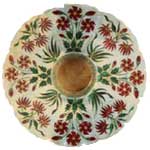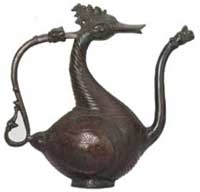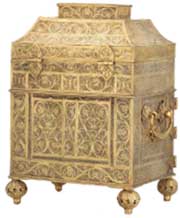| 
�
�Religion and politics have their own languages,
but the language of art is universal.�
Professor Nasser D Khalili �The very word Islam casts both light and shadow over our contemporary world. I believe there has never been a greater need for the wealth and imagination of Islamic cultures and artistic heritage to be revealed. The power of art can open our minds. One is indeed moved to consider how our modern world would be blessed if it could be rid of the radical religious fundamentalisms that so distort faiths and derail the causes of humanity and tolerance. Such musings would, I suspect, find a sympathetic ear in the one individual above all who has made this exceptional exhibition possible, Professor Nasser D Khalili.�
Edmund Capon
Director, Art Gallery of New South Wales �
Iranian-born Professor Nasser David Khalili is custodian of the world�s largest private collection of Islamic art, a passion which began as a young boy and continued into adulthood. The quest to assemble such a collection has played a central role in his life. Four years ago Edmund Capon flew to London to meet Professor Khalili to discuss bringing a selection of the finest and rarest pieces of his Islamic art collection to Australia. In June 2007 The Arts of Islam, a major exhibition consisting of more than 350 rare and beautiful pieces of Islamic art from the Khalili Collection, will open to the public at the Art Gallery of New South Wales. The Nasser D Khalili Collection of Islamic Art features over 20,000 works, many of them masterpieces. Spanning thirteen centuries, the collection is unrivalled. Islamic art may be less known and talked of within the world of art but Professor Khalili sees no reason why a Muslim artist today cannot become the next Picasso or Monet. |  |  |  |
In Islam beauty is seen as a quality of the divine, and is frequently expressed through the use of vibrant colours in illuminated manuscripts often unparalleled by other artistic cultures; superb and intricate designs and most importantly, the use of beautiful and often highly complex calligraphy not only as a tool of decoration but also as an expression of faith.
Professor Khalili is an eminent scholar, having completed a PhD in Islamic lacquerware, as well as holding chairs and professorships at various universities. He is passionate about art and collecting. One of his reasons for assembling the Khalili Collection has been to promote a greater understanding between people of different cultures and faiths and to increase awareness of the wide artistic achievements Islamic culture has provided in the realm of world art. A�devout Jew himself, his desire to encourage cross-cultural understanding led him to found the Maimonides Foundation, a charitable organisation which aims to encourage peace and understanding between Muslims and Jews and show that there is more that unites the two religions than divides them. He has often been quoted as saying �the real weapon of mass destruction is ignorance�. All Khalili�s cultural and educational endeavours, as a patron, writer and lecturer, flow from these convictions. He believes people in the West generally do not know how much they owe to the Muslim cultures. Art, he says, unites humankind.
|
 |
 |
The Arts of Islam illustrates the breadth of artistic achievement in the Islamic world from early Islam in the 7th century to the early 20th century. Objects from the early Islamic Dynasties of the 7th to 10th centuries demonstrate the artistic influences of the preceding Sasanian and Byzantine periods, and are represented by a truly unique display of colourful ceramics, lustre-painted glass and rarely preserved finely woven textiles. The medieval Islamic period (10th to early 13th century) is� considered to be a time of exceptional artistic production involving new technical innovations, such as lustre painting to glazed ceramics, as well as the introduction of new materials such as paper, and new techniques in manuscript decoration, seen in the magnificent display of illuminated Qur�ans. Islamic art following the Mongol invasions of the 13th century features refined styles heavily influenced by cultures of Central Asia and the Far East, such as China. Objects of particular interest are a saddle with brilliant delicate filigree gold trappings, dating from the 13th/14th century, and Rashid al-Din�s Jami� al-Tawarikh(Compendium of Chronicles), the first history of the world written in the 13th/14th century, seen through the eyes of the Mongol conquerors. An increase in the production of illuminated manuscripts, in particular wonderfully detailed Persian and Ottoman miniature paintings, the development and profusion of blue and white ceramic wares, as well as the emergence of fine Iznik pottery, is expressed in the splendid display of objects from the Safavid and Ottoman periods (16th to 19th centuries). One of the highlights of this display is the Shahnamah (The Book of Kings), which belonged to the Safavid ruler Shah Tahmasp (1514�76) who himself was a painter of miniatures. Colourful enamelled objects from Mughal India, intricately executed jewelled pieces studded with precious stones, and finely woven carpets and textiles also feature strongly in these periods. This breathtaking exhibition ends with pieces from the later 19th century, such as enamelled pocket watches with portraits of rulers and delicately painted lacquer pen boxes, which clearly show the European influence which was prevalent in the arts of Islam during that period. |
THE ARTS OF ISLAM
TREASURES FROM THE NASSER D KHALILI COLLECTION
Art Gallery of New South Wales
22 June � 23 September 2007
10am � 5pm daily, Wednesday until 9pm
Admission $15, concession $10
The Arts of Islam catalogue will be available in June. | | For further information please contact
Susanne Briggs
+ 61 (0)2 9225 1791 or
+ 61 (0) 412 268 320 or susanneb@ag.nsw.gov.au
| | � Principal sponsors
�  |  | � | �
Supported by |  |  |  | |  | TOP: Hookah base and mouthpiece (chillum), India, probably Mewar (Rajasthan), early 18th c AD JLY 1974
TOP ROW�LEFT TO RIGHT: Spittoon, India, Rajasthan, 18th c AD JLY 1072; Ewer in the shape of a goose or swan, Mughal India or the Deccan, 16th century AD MTW 1533; Niche carpet, probably Central Iran (Qazvin, Qum, Isfahan or Kashan), 1570s AD TXT 236
SECOND ROW LEFT TO RIGHT:�Single-volume Qur'an, Iran, Shiraz or Qazvin, Sha'ban 959 AH (July-August 1552 AD) QUR 729 (folios 1b-2a); Maharana Sangram Singh of Mewar out hunting on his horse, Jambudvipa, India, Rajastan, Udaipur, c1720-30 AD MSS 965
ABOVE RIGHT:�Silver-gilt filigree cabinet, Goa, probably 17th c AD MTW 1583 |
|
|